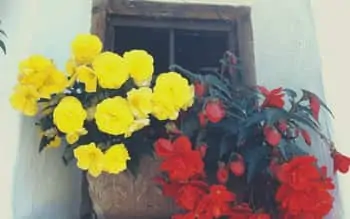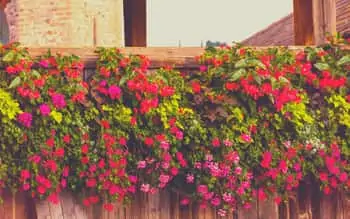Flower lovers always find a way to be curious about plants, and they are constantly analyzing and comparing different flowers. I was also one such sucker for flowers and had a garden full of every kind of flower you can find out there. I still have that garden, and it has taught me more than my botany book, no offense.
What is the Difference Between Geraniums and Begonias? The Begonias leaves are oval-shaped in various colors, usually red, white, pink, and yellow. Geraniums have soft leaves that may have a dash of color or irregular shape, depending on the variety, pink, purple, lilac, red, pink, and white.
Well, if you want to choose the perfect flower for your garden and are confused between geraniums and begonias, then I will tell you the difference between these two so you can easily decide. Geraniums and Begonias belong to two different families, and their life span also varies from each other. Their lifespan, size, conditions, and species are all different from each other.
Want to have a sneak peek at these differences? Don’t worry because I am going to tell you everything you need to know about these flowers as well as their differences.
Table of Contents
Lifespan of Geranium and Begonia

The life span of Geranium and Begonia depends upon several factors like environment, weather, and genetics. Geranium has an annual cycle, and Begonia has perennial. The life span of geranium can be 40 years or more if it is provided with proper care and a favorable environment.
The life span of tuberous Begonia can extend to 4-5 years. Judging by their lifespan, you can always decide which plant you want in your garden, and I always prefer plants with a longer life span as I can’t stand the thought of them dying. On the other hand, Begonia can only survive for 2-3 years even if you provide them with proper care, environment, and timely watering.
Family of Geranium and Begonia
Family is the most critical factor if you want to know the genetics of any flower. The families of geranium and Begonia are entirely different; in fact, they have highly different numbers of species as well. Geranium belongs to the Geraniaceae family, which has around 300 species. On the contrary, Begonia is Begoniaceae, and it has approximately 1400 species, quite a lot, right?
Color And Shape
Begonias are small flowers, ideal for home plants and or for a lively bouquet. The color and shape of a flower always adds an aesthetic tint to it and helps you decide your Instagram-friendly flowers that can slay on your feed. Begonias have glossy finish leaves that look very lavish at first sight. The color of these flowers is often darker orange or lighter red, but it varies a lot depending upon the species.
Geranium is also a tiny flower in pink, red, orange, and even white colors. Their color depends upon the environment and the species. The leaves of these flowers are scented subtly, and their stems are long. The inner central part of the petals is darker in color than the surrounding part. You can find these exquisite flowers in every pastel color except yellow.
Their Size
Size plays a significant role whenever you choose a plant for yourself, so before selecting any one of these flowers, make sure to know what size exactly you want them to be. Geraniums can be 3 feet tall commonly, but certain species of geranium are taller than 10 feet so, it’s quite a lot, frankly.
On the other hand, Begonia’s height is generally between 6-18 inches. You can get the actual size of both these flowers if you are not hindering their growth or pinching them back; also, if size does matter if you want to see your garden filled with tall and colored flowers.
How To Take Care Of Them?
When it comes to caring, geraniums are a bit easygoing, and begonias need a lot of your attention. If you want a healthy and flourishing garden, you should always know how to take care of your flowers. Some flowers demand more care and attention, so you need to spot them and give them what they want.
Geraniums require less attention and care as their life span is long and is not very sensitive or prone to damage, but if you are careless, it can also be dead.
You must not overwater your geraniums as in winters, and they require less water, so even regular water can cause overhydration and make the leaves wilt. Use fertilizers to boost growth and prevent any potential harm to the plant.
Begonias are sensitive flowers with a shorter life span, so you need to pay great heed. They cannot survive colder temperatures, unlike geraniums, so you need to save them from it, and you also need to use fertilizers to keep your flowers blooming.
Their Diseases
Your flowering plants are prone to numerous diseases, and some of them are even very deadly. Both geraniums and begonias encounter entirely different types of diseases. Some of the diseases that can damage geraniums are: i
- Pythium
- Crown rot
- Flower blight
- Root rot
- Bacterial fasciation
- Bacterial blight
- Damping-off
The diseases that pose serious harm to our delicate begonias are also very high in number and are pretty scary:
- Botrytis blight
- Powdery mildew
- Aster yellows
- Foliar nematode
- Viruses
- Rust
- Leaf spots
Diseases of both flowers vary from each other and are quite different because of such a massive difference in their families, conditions, and lifespan.
Habitat
Knowing the habitat of a plant tells you quite a lot about its nature, and when it comes to our geraniums and Begonia, their habitats are entirely opposite to each other, just like their nature. You can find geranium in:
- Savannas
- Woods
- Rocky glades
- Woodlands
- Floodplains
When it comes to our Begonia, it resides in:
- Tropical rain forests
- Moist areas
- Sub-Saharan areas
Conclusion
As we have scribbled through all differences between our two treats to eyes, I hope you have grasped the differences and have decided your favorite plant among these two. These differences of size, habitat, family, and color make them highly distinctive from each other, but each individual flower has its own qualities.
I adore both of these personally because of how aesthetically pleasing they are and how they elevate an ordinary picture to an Instagram-worthy shot.
Recent Posts
Have you found yourself wondering, 'why is my bamboo growing so slow?' Despite the fact that bamboo plants are remarkably fast-growing, it can sometimes take months (or even years!) to see any signs...
Miracle-Gro is a huge help when you are trying to get decent yields out of your plants or if you want them to thrive. However, you may have noticed that a single dose of fertilizer does little to...


